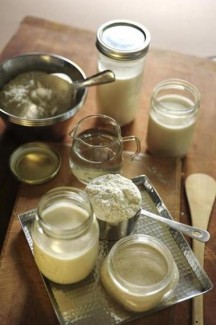Sourdough Starter

Sourdough is the unsung hero of the bread basket. Composed of little more than flour, water, salt, and a fermented starter — and more nutritious than commercially made breads — the tangy, chewy loaves are perfect for lunch-box sandwiches, and ideal for yeast-phobic bakers.
You need to begin with a starter, of course, and that’s where people get hung up. But think of a sourdough starter as Fermentation 101. A starter lasts longer than all those pickles you put up, and though it takes about the same amount of time as sauerkraut, a starter is more versatile. “It’s a science experiment you can play with,” says Gretchen Rude, a resident of Brattleboro, Vt., who has been baking with a 20-year-old starter culture for eight years. All of this makes it a kid-friendly project. Once active, a starter can be used for pizza dough, biscuits, and pancakes. Like buttermilk, the starter moistens and tenderizes quick breads, cinnamon rolls, even chocolate cake.
Establishing a sourdough culture takes about a week, and requires daily feedings of equal parts flour and water. Vigorously stirring twice each day strengthens a new starter, helping the naturally-occurring yeasts to multiply.
2 cups flour
2 cups water
1. In a large canning jar with a wide mouth, combine ½ cup flour and ½ cup water. Stir well. Cover tightly and set on the counter for 24 hours.
2. Stir well, then discard all but ½ cup starter. Add ¼ cup flour and ¼ cup water. Stir well, cover tightly, and set aside at room temperature for 24 hours, stirring twice during that time. Repeat the discarding and adding process every 24 hours for 7 days. Once the starter is bubbly, thick, with a yeasty and slightly sour scent, it’s ready to use.
3. If you use it often, store starter at room temperature and feed daily; instead of discarding some of the starter, remove what you need to make the recipe from the jar. Feed the remaining starter as before, using ¼ cup flour and ¼ cup water.
4. If you don’t plan to use it often, store the starter in the fridge and feed it weekly. Remove from fridge and feed at room temperature for 1 day before using. Discard if any mold appears. If you’re going on vacation or won’t be baking, you can store the starter in the freezer indefinitely. Thaw it at room temperature, and feed it for 2 days to wake it up.
None Available.